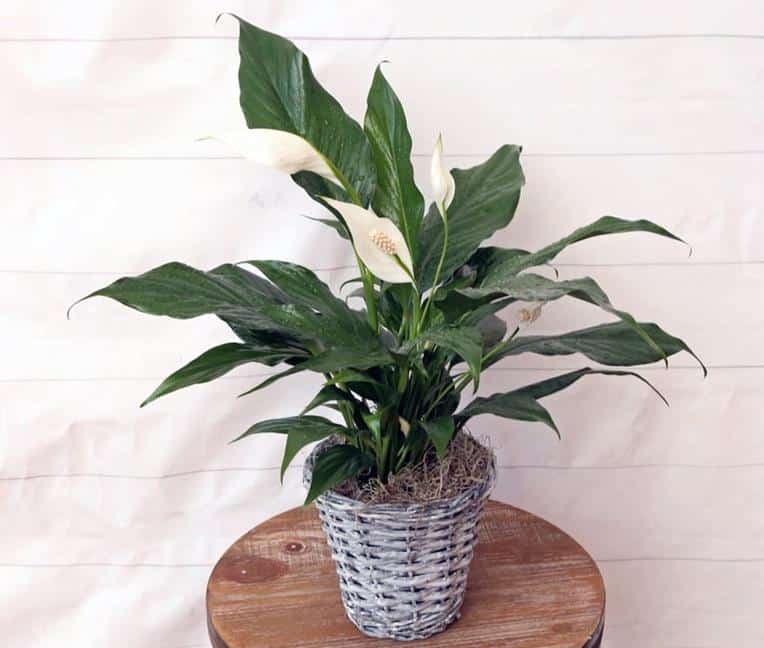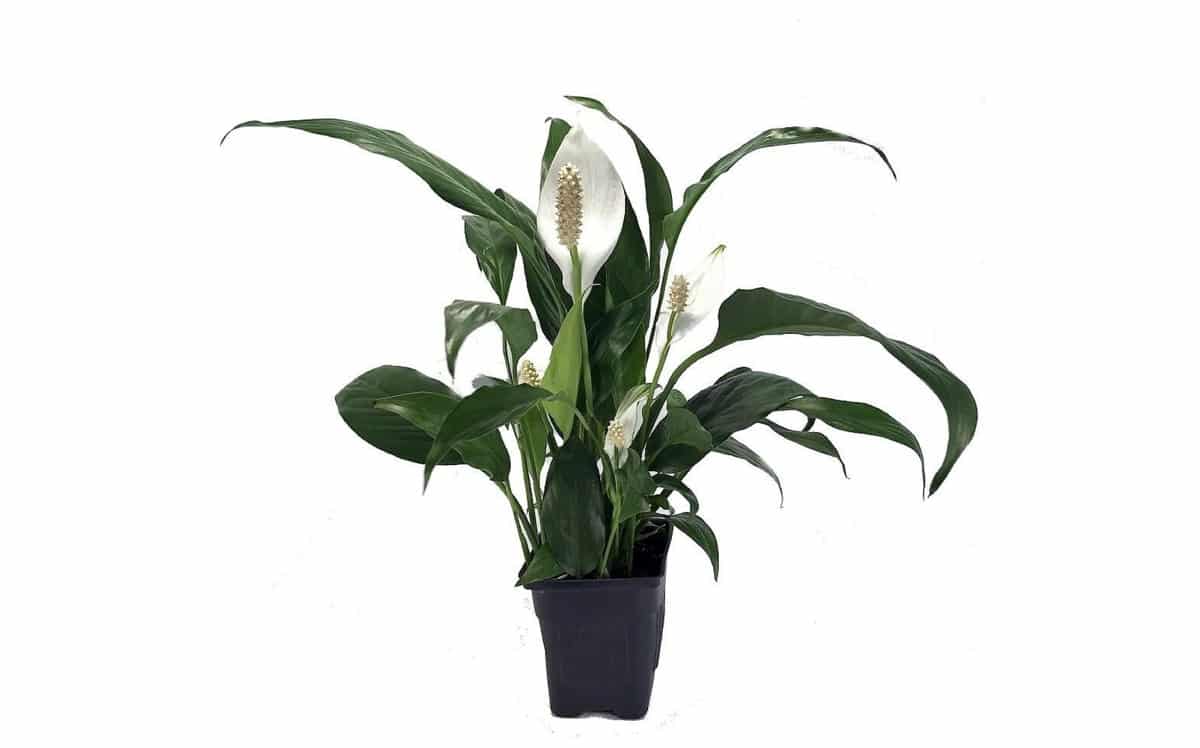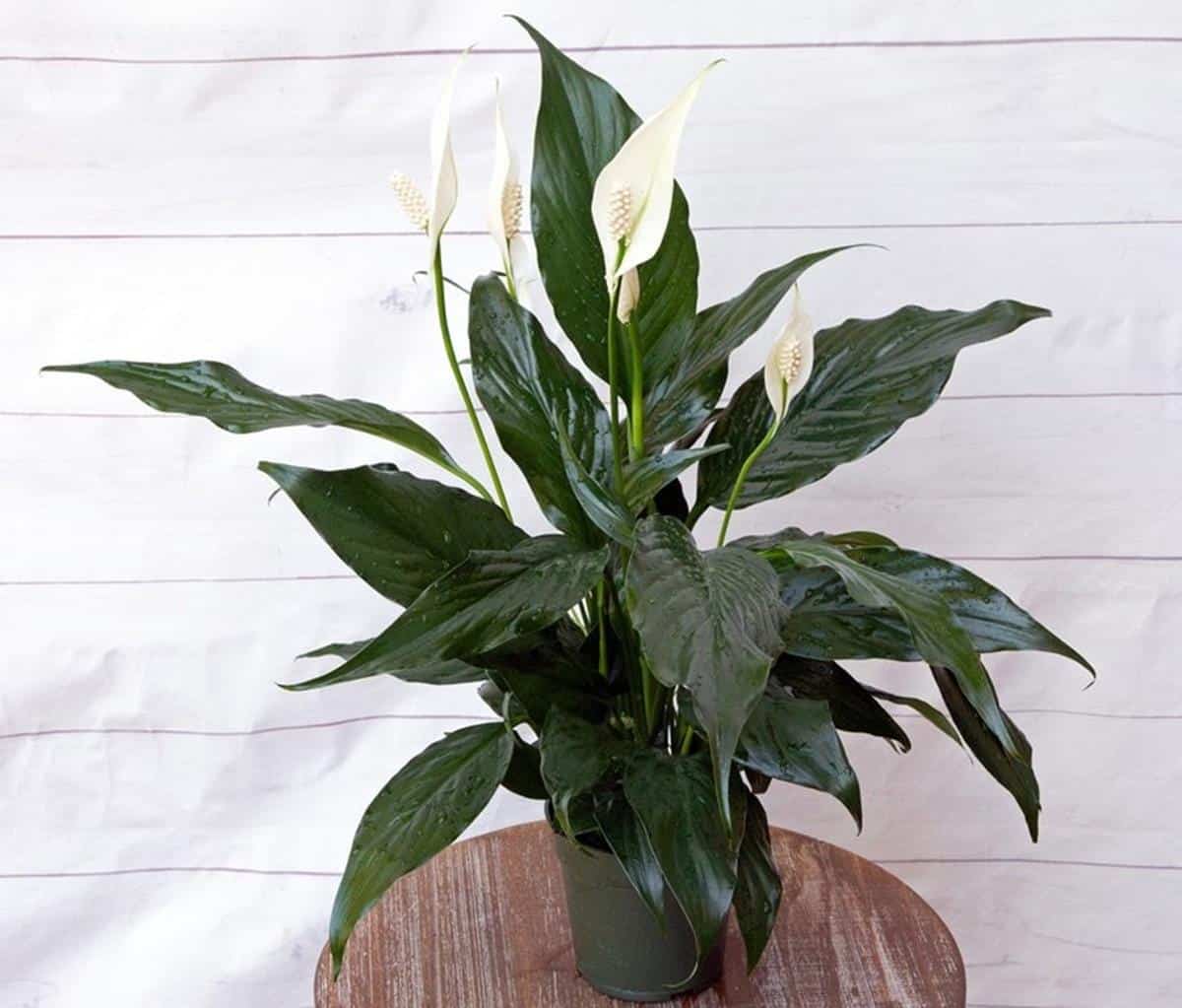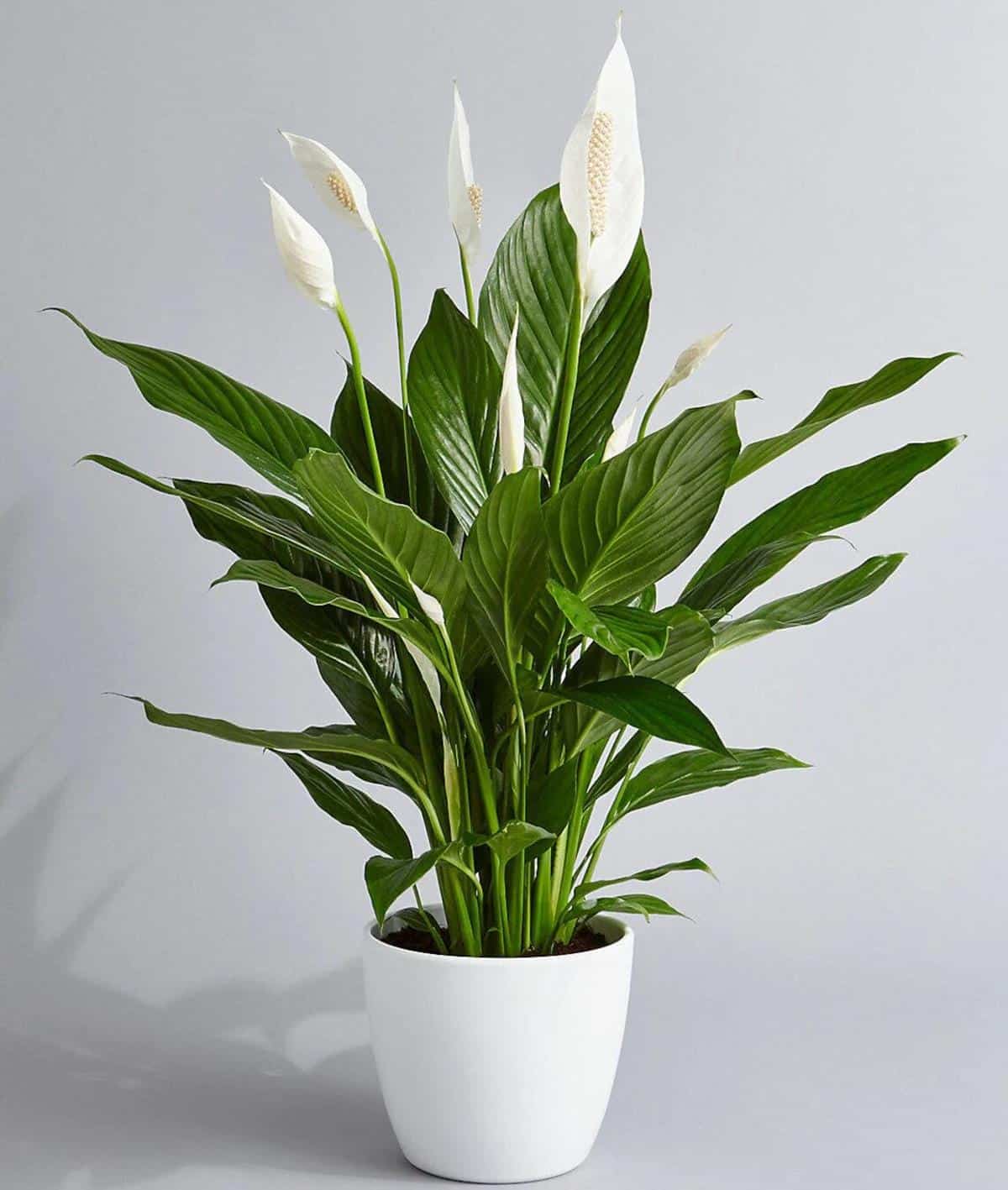Peace lily drooping or wilting is a sign of underwatering, overwatering, low humidity, too much light (sun), or heat stress. Also, it may occur due to overfeeding, pests, cold drafts, or after repotting or transplant due to shock. Sometimes, it is because of less often or expected reasons like too much dust, diseases, being rootbound.
In most cases, peace lily wilting or drooping occurs with other symptoms. Common ones include leaves curling, turning yellow or brown, including brown tips or edges. Also, you may notice leaves or flowers falling, spots, patches, stunted growth, etc.
We will give information on each of these causes, other signs your plants will have, and what to do. By considering the various symptoms, you should tell what the reason is in your particular cases.

Contents
- Peace lily care and growth requirement
- Reasons for peace lily drooping or wilting
- 1. Moisture issues
- a. Underwatering
- b. Overwatering and root rot
- 2. Low humidity
- 3. Extreme temperature
- a. Cold drafts and chilly conditions
- b. Heat stress and peace lily leaves dropping
- 4. Too much light may cause leaves to droop
- 5. Overfeeding
- 6. Rootbound
- 7. Peace lily drooping after repotting, transplant, or relocation
- 8. Pests and peace lily drooping
- Less common reasons for peace lily drooping
- 1. Dusty
- 2. Damaged stems or petiole
- 3. Diseases
- How to revive a drooping peace lily
- Frequently asked questions or FAQs
Peace lily care and growth requirement
Everyone loves Spathiphyllum or peace lily for their lovely cream or white flag or sail-like flowers, and dark green glossy leaves. These flowers symbolize peace, purity, innocence, and sympathy.
Contrary to what many assume, Spathiphyllum is not true lilies from the family Liliaceae. Instead, they are aroids or from the arum family Araceae, together with calla lily. Popular varieties are Sensation, Picasso, Clevelandii, Mauna Loa Supreme, and Domino peace lily (variegated variety). But there are many others.
These pot and houseplants are easy to care for, and wilting or drooping is a likely indicator of improper care, or you are missing some growing needs. So, we found it essential to give you care and growth requirements to help you see where you are going wrong.
| Care level | Low maintenance or easy |
| USDA hardiness zone | 11 to 12. People in this zone can grow them outdoor all year. |
| Temperature | Maintain an optimum temperature of 65 and 90°F (18 and 32 °C) and avoid sudden fluctuations. |
| Humidity | They love high humidity but can tolerate medium levels, 50% or more. |
| Light requirement | These plants prefer bright, indirect light but will still thrive under lower light. However, avoid direct sunlight. |
| Best soil | Give peace lilies well-drained, aerated and organic matter-rich soil. It should be slightly acidic, pH 5.6 to 6.5. |
| Watering | Their soil should remain moist but never soggy. Water once top one inch of the potting mix is dry. |
| Fertilizer | Spathiphyllum species are not heavy feeders. So, feed them monthly or after two months in spring and summer or growing seasons ONLY. Use a balanced houseplant fertilizer. |
| Pruning and grooming | Use a sterilized garden scissor to trim any dying, diseased, or damaged leaves near the soil line or stem. Also, shower or wipe leaves to get rid of dust. |
| Repotting | Repot or divide after 1-2 years or when rootbound. |
Reasons for peace lily drooping or wilting
Water is vital to plants as it helps maintain cell turgidity, transport nutrients, and is part of the protoplasm. Also, it serves as raw material in many processes, including photosynthesis.
That is not all. Water helps and helps keep the plant cool. How? When the plants are hot, they will open their stomata opens to allow transpiration to happen. As the water evaporates, it absorbs heat energy. Thus, your plant remains plant cool.
That said, it’s good to know that the actual reason for peace lilies drooping or wilting is not having enough water in the cells. When this happens, your plant cannot maintain turgor pressure or cell plumpness. So, the cells will collapse or become flaccid, and this will make them droop or wilt.
The various causes we are going to look at are what result makes cells not have enough water. They revolve around the soil not having water, your plant not absorbing water as usual, or losing water faster than they can absorb.
1. Moisture issues
Moisture issues, i.e., overwatering or underwatering, are common reasons for peace lily wilting or drooping.
a. Underwatering
Underwatering is the number one cause of peace lily drooping or wilting that improves with watering. These plants cannot get water because the soil is dry.
Besides wilting, your leaves will curl inward to conserve moisture and have brown crispy tips and margins, including flowers. Also, leaves and flowers may drop, and your plant will grow slowly, refuse to bloom, and wither or die if you water it for a long time.
What to do or care
Start by confirming that your plant is indeed thirsty. Feel the soil with your finger. If it is dry up to the first knuckle, it needs watering.
Another way is using a soil moisture meter. Forget the naysayers; brands like XLUX by IAGTEX, Guoevn or Sonkir are good.
If indeed watering is the reason, then give your plant a good drink. Bottom watering will best soak the soil, but top watering is ok too. Next, check if your pot is too small or your potting soil dries fast. If the pot is small, repot your plant if it is during the growing season.
On the other hand, a potting mix that dries so fast will need a little more of the coco coir or sphagnum moss and a lesser of the perlite, pumice, or bark chips.
Desist following a peace lily watering schedule. Instead, feel the soil and water when the top inch feels dry. Water needs vary with changes in environmental conditions (light, temperature, humidity, or season), plant size, pot type, or pot size.
Last but not least, to avoid neglect, set a reminder after determining how often you water your peace lily. But test the soil before watering this plant.
b. Overwatering and root rot
When you overwater your peace lily, the soil will be soggy. This will suffocate roots with oxygen making them weak and unable to absorb water or nutrients from the potting mix.
The soggy condition will favor pathogens like Cylindrocladium spathyphylli, Sclerotium rolfsii, Phytophthora parasitica, or Pythium species to attack the roots causing root rot. And as roots die, the ability to absorb water or nutrients declines. If not corrected early enough, your plant will die.
Common signs of overwatered and root rot in peace lily include the following
- Peace lily leaves yellowing, starting with the lower or older ones
- Black or brown splotches on leaves
- Wilting or drooping leaves that loo limp but feel soft, i.e., not crispy. Watering won’t improve the wilting
- Leaf drop
- Mushy stem bases
- Moldy potting mix that may have a foul smell
- Wart-like white, tan or brown lesions from leaf edema
- Stunted growth and smaller leaves
- Soft black or brown roots
What to do
Hold the watering and check if there is root rot (brown or black mushy roots). If none, improve air circulation, provide more light and optimum temperature. Then, check if your pot has drainage holes or is too large.
Also, ensure you don’t have a compacted or poorly draining potting mix. If that is the reason, use an aroid mix or buy a potting mix like Miracle-Gro Indoor Potting Mix. It has coco coir to ensure it retains water for a long time without being wet.
If there is root rot, you need to repot the plant, discarding the old potting mix. Use a fresh pot or disinfect the older one. Also, cut any black or brown roots with sterilized pruning scissors.
To help treat root rot, sprinkle some fungicide or mix one part of 3% bleach solution to two parts of water and spritz on the roots.
2. Low humidity
Low humidity will make because they will lose water fast. Also, the soil will dry quicker. If your peace lily cannot replace lost moisture, leaves will curl inward, wilt or droop, turn yellow, have brown tips and margins, and feel dry.
Your plant will grow slowly, look dull, and flowers may drop and look scorched. Also, your plant will need more water.
What to do
To monitor humidity, begin by buying a hygrometer. We like Govee Bluetooth Digital Hygrometer as it has an app to help monitor temperature or moisture level from your phone. If it is too low, do the following:
- Mist your plants several times a week but ensure the leaves don’t remain wet overnight.
- Buy a humidifier like AquaOasis™ Cool Mist Humidifier, amazon's best seller. It is quiet, runs for a day and has many awesome features.
- Make a pebble tray
- Put your plants together
- Move your houseplants to more humid rooms like your bathroom or kitchen.
3. Extreme temperature
Very high temperatures and chilly conditions, including cold drafts, are reasons for peace lily leaves drooping or wilting.
It would help if you had a thermometer to be certain temperature is the issue. Govee Hygrometer Thermometer H5075 is an excellent buy. It features both smart and basic functions. Did you know you can control it remotely? It stores data and has Smart App Alert to tell you when the temperature is beyond or below the set range.
a. Cold drafts and chilly conditions
Cold winters and breezes may make water in these plants crystalize and damage cells. As water solidifies, cells will collapse, and your plant will droop. Also, expect some discoloration, i.e., leaves may turn brown, black, yellow, or white, with some turning brown overnight and a burnt look.
What to do
When winter comes, and you are not in zone 11 or 12, move your plants indoors. Temperatures below 40°F (4.4°C) will cause damage. Also, move any plants on drafty doorways or windows. You can also have blinds on windows or cold frames to protect planters.
b. Heat stress and peace lily leaves dropping
Excessive heat will damage cells and increase water loss by transpiration from leaves. Also, the soil will dry faster. If these plants lose more water than they can absorb, drooping and wilting will occur.
Besides wilting, leaves may turn yellow, have brown crispy edges and tips, fall, and feel dry. Also, your plant will grow slowly.
That is not all. Your peace lily flowers may turn brown or get discolored, including a brown tip and margin and at times drop.
What to do
Take plants to a shade or a cooler place during hot summer days or in case of a heatwave. Next, remove any plants near a fireplace, radiator, heating system vents, or anything that emits heat.
Last but not least, avoid sudden dips in temperature. Why? It will also stress your plant since they need time to adjust to any change.
4. Too much light may cause leaves to droop
A widespread cause of peace lily leaves wilting is too much sun or light. Your plant converts any excess light energy to heat energy. Then it helps keep the plant cool by increasing transpiration.
If your plant losses more water than what roots can absorb, it will droop, curl leaves, and look faded, washed out, or turn yellow, especially those near the light source. Also, leaves will have a burnt look, including flowers, but they won’t fall easily.
Some people have noted peace lily flower turning green when under too much light. It may be due to too much chlorophyll formation.
What to do
Spathiphyllum will grow well low to bright indirect light. Even in the wild, they get filtered light as rainforest understory plants. So, avoid direct sunlight.
People growing them outside need a shade or a greenhouse. Inside your home, put them at a distance from the window, where direct sunlight doesn’t reach, especially on the south-facing window.
Even for the west-facing window, don’t let late afternoon sunlight reach your plant.
5. Overfeeding
Too much fertilizer will result in the accumulation of salts in the soil and may burn roots. So, your plant won’t absorb water or nutrients from the potting mix. In extreme cases, the potting media may draw water from roots.
Without water, you expect these plants to wilt or droop, curl leaves, and fertilizer burns. Also, your plant will grow slowly, leaves will fall, and your plant may not bloom.
What to do
Start by leaching or flushing the soil, i.e., pouring a lot of water through it for like half an hour. Next, reduce fertilizers as these plants are not heavy feeders. Thus, feed these aroids with a balanced houseplant fertilizer once in 1-2 months during the growing seasons only.
6. Rootbound
Peace lily plant drooping or wilting and roots growing from drainage holes signify your plant is rootbound. When this happens, it means your plant has overgrown the pot, has no new soil to grow into, and cannot get enough water or nutrients.
More signs to expect include leaves curling, turning yellow, dropping, having crispy brown tips and margins, slow growth. Also, the root will be spiraling around the pot, and your plant will look leggy and have smaller leaves.
What to do
Your plant needs repotting or division. So, if it is during the growing seasons (spring or summer), repot your plant. When repotting it, gently slide it out, remove as much soil as possible and repot it to a larger pot or divide your plant.
7. Peace lily drooping after repotting, transplant, or relocation
Is your peace lily drooping after repotting, transplant, relocating? It indicates that your plant is under repotting or transplant shock and may also happen to a new plant you just received.
The wilting and drooping sign that you have yet to acclimatize or adjust to the new change. Thus, it cannot absorb water, nutrients or perform other plant functions as usual.
Leaves may also turn yellow, fall, curl, have dry brown tips or edges, and your plant will grow slowly. Also, flowers may drop or look scorched.
What to do
When transplanting or repotting, minimize root damage and do it in the early mornings, not hot afternoons. Next, make sure the soil is always moist but not soggy and maintain ideal temperature, humidity and provide bright, indirect light.
8. Pests and peace lily drooping
Pests are not common in indoor Spathiphyllum but can occur. Bugs like whiteflies, thrips, scale insects, spider mites, or aphids, will suck plant juices depriving it of nutrients and water. This will make your peace lily droop or wilt.
You may see the bugs, i.e., small, bump or dot that may move, fly, or remain stationary and black, silvery, brown, or yellow spots and mishappen, curly, deformed, ruffled, or twisted leaves. Also, the leaves and flowers may drop prematurely, and your plants will grow slowly.
Some signs will be specific to the bug, like honeydew and sooty mold, webbing, silvery stippling, and so on.
Last but not least, others like fungus gnat’s larvae will feed on roots causing stunted growth, yellow leaves, and sudden wilting or drooping.
What to do
Isolate new plants or infested ones and use insecticidal soap, horticultural oil sprays, or neem oil. A 3-in-1 product like Bonide Ready to Use Neem Oil will help you much.
For some, you need to hose your plant. And if it’s fungus gnats, pour one part of hydrogen peroxide mixed with four parts of water into the soil.
Less common reasons for peace lily drooping
Some of the less common reasons for wilting or drooping include the following:
1. Dusty
Dusty leaves may affect transpiration (increase or decrease) and the food-making process. For instance, by making your plants transpire more, your plant may wilt if roots cannot supplement the lost water.
On the other hand, if it slows transpiration, plants will not draw water from roots. Again, they may wilt.
What to do
Give your plant a shower when leaves become dusty. You can also wipe them with a soft, damp cloth.
2. Damaged stems or petiole
Any physical damage to the stem or petiole including will make water movement from roots to leaves impossible. Why? Because your xylem that conveys water may also get damaged.
3. Diseases
Besides root rot which we have seen, some diseases may also cause Spathiphyllum wilting. This occurs if they affect the stems or petiole, making it impossible for water movement.
One such disease is aerial blight. It will cause large brown or purple spots or lesions on stems. Also, gray or brownish lesions on leaves are possible, and this condition may cause some wilting and leaf drop, among other symptoms.
Discard infected plants and apply fungicide as a preventive measure. Also, you can use any product that has Fosetyl-Al and Phosphorous Acid and keep foliage dry.
How to revive a drooping peace lily
Can you revive or save a drooping or wilted peace lily? The answer is yes, even if it looks very droopy, limp, or wilted but not dead. But not all cases are salvageable. It may be impossible to save some wilting from root rot in advanced stages or from some disease.
To revive a droopy peace lily, you need to begin by identifying the underlying cause. We already have given you each reason and what to do. Here is a summary
| Cause | How to revive your plant or wilting care |
| Underwatering | Thoroughly and evenly water your plant and ensure the pot is large enough and the potting mix holds moisture without being soggy. |
| Overwatering | Hold watering and provide bright light, optimum temperature, and improve air circulation. Also, ensure potting mix drains, pot has drainage holes, and it is not too large. |
| Root rot | Repot your plant, removing any brown or black roots with sterilized scissors. Also, use a fungicide. |
| Low humidity | Ensure your plant gets enough water and raise humidity using a humidifier, misting it a few times a week, or having a pebble tray. Also, you can move it to humid rooms like the bathroom or group them. |
| Heat stress | Move your plant to a cooler place or shade and turn on your HVACs |
| Cold draft | In winter, move plants indoors or away from drafty areas to warmer, less windy places. |
| Repotting or transplanting shock | Keep the soil moist and maintain optimum growing conditions. Don’t fertilize your plant at this moment. |
| Pests | Hose them off your plant, use neem oil, insecticidal soaps, or horticultural spray oils |
| Rootbound | Repot your plant if it is during the growing seasons or late winter. |
| Overfeeding | Leach or flush the soil and only fertilizer your plant after a month or two with a balanced houseplant fertilizer |
Frequently asked questions or FAQs
Peace lily drooping, yet the soil is still moist signifies overwatering or root rot. Other possible causes are diseases, pests, chilly conditions, or cold drafts. Also, too much light, low humidity, or heat stress are possible if the water loss rate on leaves surpass what roots can absorb.
Underwatering, low humidity, heat stress, and too much light are the common causes of peace lily drooping and brown tips. However, transplant shock, rootbound, or too much fertilizer may make your plant wilt and have brown tips.
Peace lily drooping even after watering is a likely sign of overwatering or root rot. But it may be low humidity, too much light, heat stress, cold drafts, or pests. Watering may not solve the issue if plants lose more water than roots can absorb.
Peace lily drooping and turning yellow is a sign of overwatering, underwatering, low humidity, heat stress, too much light, cold drafts, rootbound, plant shock, pests, diseases, etc. Virtually every reason we have seen will cause foliage discoloration, including browning.
Not necessarily. Your peace lily is only sending you a warning sign that something is missing. If you fix it in time, it will survive. But if its root rot at its advanced stage, your plant will be dying.
If your peace lily keeps wilting or is always droopy, possible causes are overwatering, root rot, or low humidity. Also, it can happen if your potting mix doesn’t hold moisture, your pot is too small, or your plant is rootbound.
Things like too much heat or light will not make the plant droop at night. For pests, it can only happen when there is a heavy infestation.





Leave a Reply